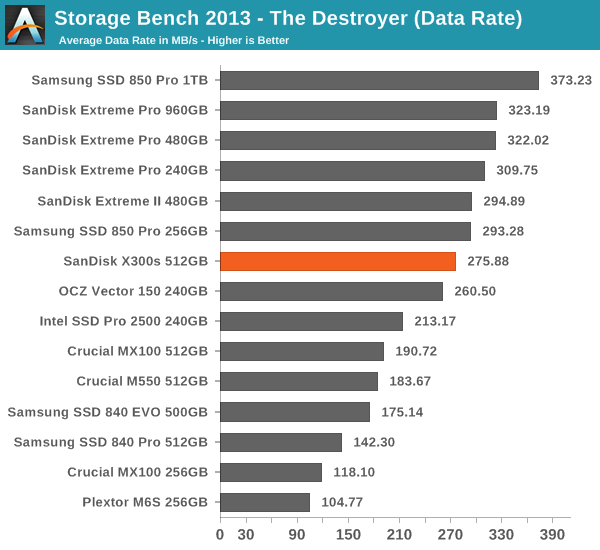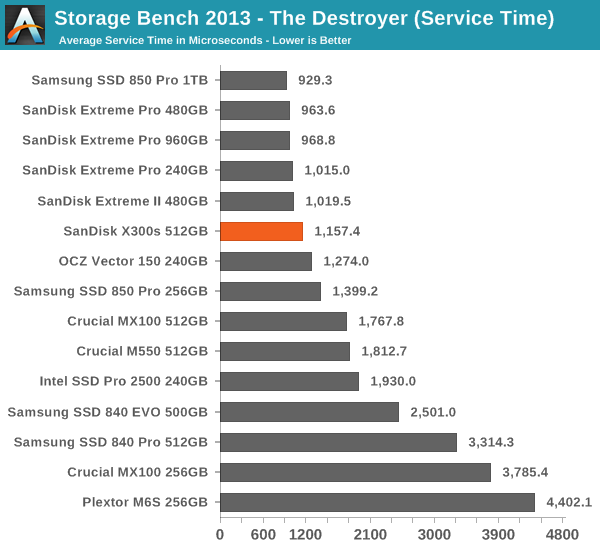SanDisk X300s (512GB) Review
by Kristian Vättö on August 21, 2014 2:15 PM ESTAnandTech Storage Bench 2013
Our Storage Bench 2013 focuses on worst-case multitasking and IO consistency. Similar to our earlier Storage Benches, the test is still application trace based – we record all IO requests made to a test system and play them back on the drive we are testing and run statistical analysis on the drive's responses. There are 49.8 million IO operations in total with 1583.0GB of reads and 875.6GB of writes. I'm not including the full description of the test for better readability, so make sure to read our Storage Bench 2013 introduction for the full details.
| AnandTech Storage Bench 2013 - The Destroyer | ||
| Workload | Description | Applications Used |
| Photo Sync/Editing | Import images, edit, export | Adobe Photoshop CS6, Adobe Lightroom 4, Dropbox |
| Gaming | Download/install games, play games | Steam, Deus Ex, Skyrim, Starcraft 2, BioShock Infinite |
| Virtualization | Run/manage VM, use general apps inside VM | VirtualBox |
| General Productivity | Browse the web, manage local email, copy files, encrypt/decrypt files, backup system, download content, virus/malware scan | Chrome, IE10, Outlook, Windows 8, AxCrypt, uTorrent, AdAware |
| Video Playback | Copy and watch movies | Windows 8 |
| Application Development | Compile projects, check out code, download code samples | Visual Studio 2012 |
We are reporting two primary metrics with the Destroyer: average data rate in MB/s and average service time in microseconds. The former gives you an idea of the throughput of the drive during the time that it was running the test workload. This can be a very good indication of overall performance. What average data rate doesn't do a good job of is taking into account response time of very bursty (read: high queue depth) IO. By reporting average service time we heavily weigh latency for queued IOs. You'll note that this is a metric we have been reporting in our enterprise benchmarks for a while now. With the client tests maturing, the time was right for a little convergence.

Due to the lower over-provisioning, the X300s ends up being slightly slower than the Extreme Pro and Extreme II. Still, the X300s is a solid performer and faster than e.g. Intel's SSD Pro 2500, which is Intel's offering to the business market. Ultimately the 850 Pro is the fastest SED on the market but the X300s provides a more complete set of features with the inclusion of Wave's EMBASSY Security Control.











34 Comments
View All Comments
Kristian Vättö - Friday, August 22, 2014 - link
That is not true. Windows 7 is still the dominant OS in the enterprise space with Windows 8 only having a marginal share:http://www.sysaid.com/company/press/382-global-win...
Yes, that is one-year-old data but it shows that enterprises are not very keen on W8 and are adopting it very slowly. That in turn leaves a huge market for solutions like Wave ECS since the BitLocker in Windows 7 does not support Opal.
Besides, eDrive/BitLocker is the same for every drive. I don't see the need to revisit it with this drive because the process is not any different.
cbf - Friday, August 22, 2014 - link
Well, that market share article is from June 2013.While, I don't think Windows 8.1 is taking the market by storm, I think it is creeping in. I've deployed it due to things like improved startup/hibernation, BitLocker improvements, etc. The start menu just isn't that big a deal for my users.
In any event, it looks like we'll see Win 9 in the next six months, which I predict enterprises will deploy as fast as they've ever deployed any new Windows OS, so that should settle the issue.
jabber - Saturday, August 23, 2014 - link
Maybe not.Windows 9 is too soon. A lot of corps are only two years into their OS refresh, they aren't going to change till maybe 2017 at the earliest and then 10 is round the corner. A lot haven't moved to 7 till this year so they are going to hang around till 2020. Windows 10 will be the one that fits the schedule better.
9 will bomb probably. Plus anyone knows that 9 is purely a rushed damage limitation excercise.
devione - Thursday, August 21, 2014 - link
Hi Kristian,Really appreciate your efforts. However would it be possible to see future reviews involving Enterprise-grade SSDs? Thanks for your time.
Kristian Vättö - Friday, August 22, 2014 - link
Yeah, we have something in the works :)jay401 - Friday, August 22, 2014 - link
By the way, the Samsung 840 Evo in 256GB and 512GB sizes just dropped $20 and $50 in price on Amazon. $119 and $199 respectively, though the 500GB did just bump back up slightly to $212.7amood - Friday, August 22, 2014 - link
I appreciate the SEDs but I think these aren't open source and can't be audited like TC which is being audited right now. How to know for sure that the SED encryption is secure and doesn't have backdoor code for the spying?fk- - Saturday, August 23, 2014 - link
I'm still a bit confused about one thing - with all that security software listed in the table, what are the motherboard requirements to use the encryption on this drive? Do I still need a motherboard capable of setting ATA password if I want to password-protect the data on the drive?Or, to put it straight, is there any [software] way to use the option to password-protect the drive (and being prompted to enter the password on startup) on an older motherboard without UEFI, without ATA password capabilities and without Opal certification?
Kristian Vättö - Sunday, August 24, 2014 - link
Wave's ECS should do that as long as the drive is Opal certified. I tested without UEFI and it worked fine, and ATA password is just a BIOS feature whereas Opal is independent from the rest of the system (i.e. should work with any motherboard or system).mike8675309 - Sunday, August 24, 2014 - link
I assume that when you use the took to secure erase that when you enter the PSID that the drive is no deactivating the encryption, and then secure erasing the drive. Using that tool and that process must do something more complex so that avoids creating an attack vector.